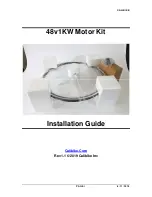
12
13
IV. BEFORE YOU RIDE
WARNING: Loose or damaged handlebar grips or extensions can cause
you to lose control and fall. Unplugged handlebars or extensions can cut you
and cause serious injury in an otherwise minor accident.
D. FIRST RIDE
When you buckle on your helmet and go for your first familiarization
ride on your new bicycle, be sure to pick a controlled environment, away
from cars, other cyclists, obstacles or other hazards. Ride to become
familiar with the controls, features and performance of your new bike.
Familiarize yourself with the braking action of the bike (see Section VII.
C). Test the brakes at slow speed, putting your weight toward the rear
and gently applying the brakes, rear brake first. Sudden or excessive
application of the front brake could pitch you over the handlebars.
Applying brakes too hard can lock up a wheel, which could cause you to
lose control and fall. Skidding is an example of what can happen when
a wheel locks up. If your bicycle has toeclips or clipless pedals, practice
getting in and out of the pedals. See Section VII. E.
Practice shifting the gears (see Section VII. D) . Remember shifting
with an internal gear system is best done when coasting, stopped, or
back pedaling. Unlike an external derailleur system, the internal system
should not be shifted while pedaling. If you must shift while pedaling,
reduce your pressure on the pedals. Excessive tension on the chain
makes shifting difficult. Check out the handling and response of the
bike; and check the comfort. If you have any questions, or if you feel
anything about the bike is not as it should be, consult your qualified local
bicycle shop before you ride again.
V. SAFETY
A. THE BASICS
WARNING: The area in which you ride may require specific safety
devices. It is your responsibility to familiarize yourself with the laws of the
area where you ride and to comply with all applicable laws, including properly
equipping yourself and your bike as the law requires. Observe all local bicycle
laws and regulations. Observe regulations about bicycle lighting, licensing of
bicycles, riding on sidewalks, laws regulating bike path and trail use, helmet
laws, child carrier laws, special bicycle traffic laws. It’s your responsibility to
know and obey the laws.
1.
Always wear a cycling helmet which meets the latest Consumer
Product Safety Certification standards and is appropriate for the
type of riding you do. Always follow the helmet manufacturer’s
instructions for fit, use and care of your helmet. Most serious bicycle
injuries involve head injuries which might have been avoided if the
rider had worn an appropriate helmet.
WARNING: Failure to wear a helmet when riding may result in
serious injury or death.
2.
Always do the Mechanical Safety Check (Section IV. C) before you
get on a bike.
3.
Be thoroughly familiar with the controls of your bicycle: brakes
(Section VII. C); pedals (Section VII. E); shifting (Section VII. D)
4.
Be careful to keep body parts and other objects away from the sharp
teeth of chainrings, the moving chain, the turning pedals and cranks,
and the spinning wheels of your bicycle.
5.
Always wear:
•
Shoes that will stay on your feet and will grip the pedals. Make
sure that shoe laces cannot get into moving parts, and never ride
barefoot or in sandals.
•
Bright, visible clothing that is not so loose that it can be tangled in
the bicycle or snagged by objects at the side of the road or trail.
Handwear/gloves that will protect your hands, improve your grip, and
help delay hand fatigue.
•
Protective eyewear, to protect against airborne dirt, dust and bugs
— tinted when the sun is bright, clear when it’s not.
6.
Don’t jump with your bike. Jumping a bike can be fun; but it can put
huge and unpredictable stress on the bicycle and its components.
Riders who insist on jumping their bikes risk serious damage, to their
bicycles as well as to themselves.
7.
Ride at a speed appropriate for conditions. Higher speed means
higher risk.
B. RIDING SAFETY
1.
Obey all Rules of the Road and all local traffic laws.
2.
You are sharing the road or the path with others — motorists,
pedestrians and other cyclists. Respect their rights.
3.
Ride defensively. Always assume that others do not see you.
4
. Look ahead, and be ready to avoid:
•
Vehicles slowing or turning, entering the road or your lane ahead of
you, or coming up behind you.
•
Parked car doors opening.
•
Pedestrians stepping out.
•
Children or pets playing near the road.
•
Pot holes, sewer grating, railroad tracks, expansion joints, road
or sidewalk construction, debris and other obstructions that could
cause you to swerve into traffic, catch your wheel or cause you to
have an accident.
•
The many other hazards and distractions which can occur on a
bicycle ride.
5.
Ride in designated bike lanes, on designated bike paths or as close to
the edge of the road as possible, in the direction of traffic flow or as
Summary of Contents for Carolina
Page 1: ......



































